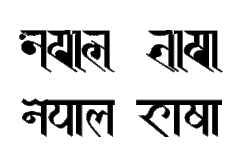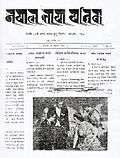Newar language
Nepal Bhasa is a language spoken by indigenous Newa people of Nepal. It is a Himalayan language of Tibeto-Burman branch of the Sino-Tibetan languages group.
| Newa | ||||
|---|---|---|---|---|
| Nepal Bhasa नेवाः भाय् Newāh Bhāy | ||||
 The word "Nepal Bhasa" written in the Ranjana alphabet and the Prachalit Nepal alphabet | ||||
| Native to | Nepal | |||
| Ethnicity | 1.26 million Newa people (2001 census?)[1] | |||
| Native speakers | 860,000 (2011 census)e18 | |||
| Language family | Sino-Tibetan
| |||
| Early forms: | Classical Newa
| |||
| Dialects |
Dhankuta
Chitlang
| |||
| Writing system | Ranjana alphabets and various in the past, Devanagari currently | |||
| Official status | ||||
| Regulated by | Nepal Bhasa Academy | |||
| Language codes | ||||
| ISO 639-2 | new | |||
| ISO 639-3 | Either: new – Newar nwx – Middle Newa | |||
| Linguist List | newa Nepal Bhasa | |||
| nwx Middle Newa | ||||
| ||||
Newah Bhaaye is the term used for Nepal Bhasa by its native speakers. The term 'Newari' has been used in derogatory form to replace the original name of the language. [2]
Linguistics
Nepal Bhasa shares the feature of Kirant and Tibetan dialects of Northern Himalayas. It consists of five major dialects and several sub-dialects spoken by Newa people living throughout the country.
Newar Language Media
A line from an inscription dated 1706 using the term "Nepāla Bhāṣā" in Pracalit script to refer to the language.
A stone inscription in Classical Newar at Bhaktapur.
Copper plate inscription at Swayambhunath, dated Nepal Sambat 1072 (1952 AD)
A page from a Astrology book from 1480 written in Newar.
'Aesop's Fables' in Newar by Jagat Sundar Malla, first published in 1915.
ka kha yā mye ("a song of ka and kha"), a Newar language poem written by Briddhi Lakhmi, the queen consort of Bhaktapur.[3]
References
- ↑ Newa at Ethnologue (15th ed., 2005)
- ↑ Kapali, Rukshana (2018-12-08). "Why using the word 'Newari' is problematic". Rukuchee Blog. Retrieved 2018-12-13.[dead link]
- ↑ Tuladhar 2000, p. 64.
| This language has its own Wikipedia project. See the Newar language edition. |









